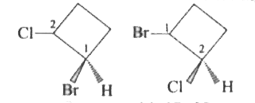A compound of vanadium has a magnetic moment of 1.73BM Work out the electronic configuration of vanadium in the compound
To determine the electronic configuration of vanadium in the given compound with a magnetic moment of 1.73 Bohr Magneton (BM), we can follow these steps:
Step 1: Understand the Magnetic Moment Formula
The magnetic moment (μ) for a paramagnetic substance is given by the formula:
μ=√n(n+2) BM
where n is the number of unpaired electrons.
Step 2: Set Up the Equation
Given that the magnetic moment is 1.73 BM, we can set up the equation:
√n(n+2)=1.73
Step 3: Square Both Sides
Squaring both sides to eliminate the square root gives:
n(n+2)=(1.73)2
Calculating (1.73)2:
(1.73)2≈2.9929
So, we have:
n(n+2)=2.9929
Step 4: Solve the Quadratic Equation
This results in the quadratic equation:
n2+2n−2.9929=0
Using the quadratic formula n=−b±√b2−4ac2a where a=1,b=2,c=−2.9929:
n=−2±√(2)2−4⋅1⋅(−2.9929)2⋅1
Calculating the discriminant:
b2−4ac=4+11.9716=15.9716
Thus,
n=−2±√15.97162
Calculating √15.9716≈4:
n=−2±42
This gives us two potential solutions for n:
1. n=1 (taking the positive root)
2. n=−3 (not physically meaningful)
Step 5: Determine the Oxidation State
Since we found n=1, this means there is 1 unpaired electron in the vanadium compound.
Step 6: Write the Electronic Configuration of Vanadium
Vanadium (V) has an atomic number of 23, and its ground state electronic configuration is:
V: 1s22s22p63s23p64s23d3
Step 7: Determine the Oxidation State in the Compound
To achieve 1 unpaired electron, we need to remove electrons from the outermost shells. The outermost electrons are in the 4s and 3d subshells.
1. Remove 2 electrons from the 4s subshell.
2. Remove 2 electrons from the 3d subshell.
This results in the following configuration:
V+4:1s22s22p63s23p63d1
This configuration has 1 unpaired electron in the 3d subshell, which corresponds to the magnetic moment of 1.73 BM.
Conclusion
The electronic configuration of vanadium in the compound is:
V+4:1s22s22p63s23p63d1
The magnetic moment (μ) for a paramagnetic substance is given by the formula:
μ=√n(n+2) BM
where n is the number of unpaired electrons.
Given that the magnetic moment is 1.73 BM, we can set up the equation:
√n(n+2)=1.73
Squaring both sides to eliminate the square root gives:
n(n+2)=(1.73)2
Calculating (1.73)2:
(1.73)2≈2.9929
So, we have:
n(n+2)=2.9929
This results in the quadratic equation:
n2+2n−2.9929=0
Using the quadratic formula n=−b±√b2−4ac2a where a=1,b=2,c=−2.9929:
n=−2±√(2)2−4⋅1⋅(−2.9929)2⋅1
Calculating the discriminant:
b2−4ac=4+11.9716=15.9716
Thus,
n=−2±√15.97162
Calculating √15.9716≈4:
n=−2±42
This gives us two potential solutions for n:
1. n=1 (taking the positive root)
2. n=−3 (not physically meaningful)
Since we found n=1, this means there is 1 unpaired electron in the vanadium compound.
Vanadium (V) has an atomic number of 23, and its ground state electronic configuration is:
V: 1s22s22p63s23p64s23d3
To achieve 1 unpaired electron, we need to remove electrons from the outermost shells. The outermost electrons are in the 4s and 3d subshells.
2. Remove 2 electrons from the 3d subshell.
V+4:1s22s22p63s23p63d1
This configuration has 1 unpaired electron in the 3d subshell, which corresponds to the magnetic moment of 1.73 BM.
The electronic configuration of vanadium in the compound is:
V+4:1s22s22p63s23p63d1
Topper's Solved these Questions
- ATOMIC STRUCTUREBOOK - CENGAGE CHEMISTRY ENGLISHCHAPTER - ATOMIC STRUCTUREEXERCISE - Exercises (Subjective)
52 Videos
- ATOMIC STRUCTUREBOOK - CENGAGE CHEMISTRY ENGLISHCHAPTER - ATOMIC STRUCTUREEXERCISE - Exercises Linked Comprehension
50 Videos
- APPENDIX - INORGANIC VOLUME 1BOOK - CENGAGE CHEMISTRY ENGLISHCHAPTER - APPENDIX - INORGANIC VOLUME 1EXERCISE - chapter-7 Single correct answer
1 Videos
- CHEMICAL BONDING AND MOLECULAR STRUCTUREBOOK - CENGAGE CHEMISTRY ENGLISHCHAPTER - CHEMICAL BONDING AND MOLECULAR STRUCTUREEXERCISE - Archives Subjective
15 Videos
Similar Questions
A compound of vanadium possesses a magnetic moment of 1.73BM. The oxidation state of vanadium in this compounds is:
View SolutionMagnetic moment of a compound of vanadium is 1.73 BM. Write the number of unpaired electron and the electronic configuration of Vanadium in this compound .
View SolutionA compound of vanadium chloride has spin only magnetic moment of 1.73 BM. Its formula is
View SolutionA compound of vanadium has a magneitc moment (μ) of 1.73BM. If the vanadium ion in the compound is present as Vx+, then, the value of x is ?
View SolutionFind electronic configuration and magnetic moment of Gd3+
View SolutionParamagnetism is a property due to the presence of unpaired electrons. In case of transition metals, as they contain unpaired electrons in the (n−1) d orbitals , most of the transition metal ions and their compounds are paramagnetic. Para magnetism increases with increases in number of unpaired electrons. Magnetic moment is calculated from 'spin only formula' Vz
μ=√n(n+2)B.Mn=number of unpaired electrons
Similarly the colour of the compounds of transition metals may be attributed to the presence of incomplete (n−1) d sub-shell. When an electron from a lower energy of d-orbitals is excited to a higher energy d-orbital, the energy of excitation corresponds to the frequency of light absorbed. This frequency generally lies in the visible region. The colour observed corresponds to complementary colour of the light observed. The frequency of the light absorbed is determined by the nature of the ligand.
Titanium shows magnetic moments of 1.73BM in its compound. What is the oxidation state of titanium in the compound?
View SolutionIn which compound does vanadium has an oxidation number of +4 ?
View SolutionThe complex compound havimg maximum magnetic moment is
View SolutionThe configuration of 1 and 2 carbon atom in the following compounds is :

View SolutionIn which compound does vanadium have an oxidation number of +4?
View Solution
